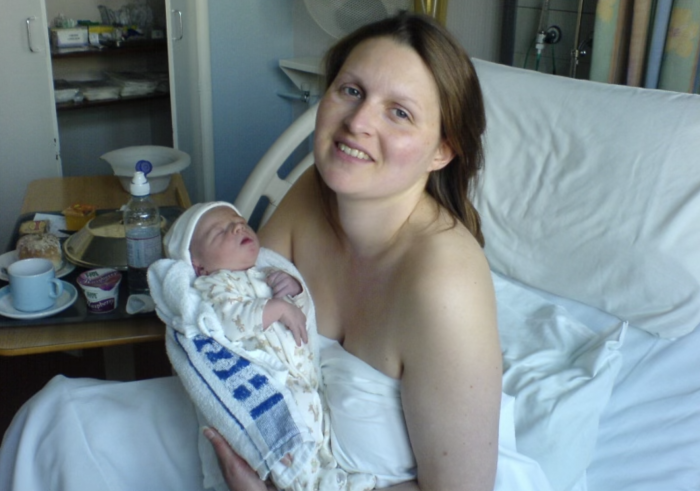The birth of my first child didn’t go to plan.
I was persuaded to remain in an unnatural position on the hospital bed rather than upright, mobile, or in a natural birthing position.
It wasn’t pleasant for myself or my baby. He became stressed, resulting in me laid on my back with my feet in stirrups whilst a room full of medical staff monitored his heart rate and instructed me to push.
I vowed never to go through that again!
Whilst upset that I didn’t experience the birth I’d hoped for, I had to admit that I was poorly prepared—I hadn’t done my research. Having read only one mainstream book on pregnancy and attended an NHS run class at the local hospital, I was ignorant of what it would actually feel like in the moment.
When I was fortunate enough to fall pregnant with my second child, a fellow mum offered me the loan of her copy of Ina May’s Guide to Childbirth by Ina May Gaskin.
In this book, she explains:
“The best way I know to counter the effects of frightening stories is to hear or read empowering ones. I mean stories that change you because you read or heard them, because the teller of the story taught you something you didn’t know before or helped you look at things from a different angle than you ever had before.”
I read about the kind of natural births that I aspired to, and her words confirmed what I already felt. I had the ability to birth my baby naturally, without intervention, and in a far more comfortable, relaxed manner than I had experienced with my first.
The Good
Her book features many inspiring birth stories, some of which demonstrate the mind/body connection in a way that medical studies have not.
One topic discussed is visualisation. She describes the link between imagery and birthing and introduces the use of the Sheela-na-gig, or that of an open blossom.
Images of babies crowning from the flowers themselves help pregnant women to imagine both the cervix and the vaginal opening like layers of an unfolding flower.
During her own first labor, she managed to get into a trance-like state by visualising that she was a large mountain lion.
I have read the success stories and heard first-hand from mothers who used visualisation techniques, image cards, and childbirth-focussed meditations with what they believed to be positive outcomes.
Having been inspired by these empowering tales, I started to form a visualisation in my mind.
The Bad
I created a detailed scene to replay on repeat during the final months of my pregnancy. I was engrossed in the film I developed in my head.
I was careful to repeat it exactly as it was on each occasion that I ‘watched’ it.
I had a large reservoir of water, blocked by a huge dam—think James Bond, Goldeneye. The dam held the water back from a fairly small river, which was short, then opened out into the sea.
On the reservoir was a wooden rowing boat, but it was a complete shell, like a hollow nut; there was no seating in it. I envisaged the wind starting to blow and make gentle waves on the surface of the water, moving the boat toward the dam.
The wind intensified and the waves grew bigger—the boat was knocked into the dam. With each wave, the force grew, and the boat began to damage the dam—cracks were appearing, stones falling. The wind strengthened, the waves were powerful and the boat was visibly breaking the dam. The boat hit hard, and as the rhythm quickened, the dam gave way and the boat was washed down the river at speed with the force of the water carrying it.
In hindsight, it’s obvious where I went wrong, and yet still surprising to me how literally my body received my instructions.
My labor was short. My contractions quickened quickly. Just as I had watched the wind growing stronger and the waves getting bigger, my baby was being thrust downwards, as the boat had been forced into the dam.
I gave birth to my daughter, unassisted in my bathroom after my second stage consisted of only three contractions. My water’s went—she crowned—I held her.
We were both in shock, I think. The midwife, who was on her way to my planned home birth, was a little surprised too.
The Ugly
When I found out I was expecting again, I was determined to get it right. It obviously worked; it was just my implementation that had been poorly executed. I thought about how I needed to change my mental video to plan for a more relaxed birth.
I used the same reservoir and boat but made the dam smaller and narrower. I slowed the speed at which the wind intensified. I made the boat knocking into the dam gentle, only growing in force gradually. It took far longer for the dam to give, and when it did, it just let the boat through a gap; it wasn’t entirely destroyed by the process.
My mindset was focused on calm and steady.
Oh, boy, does my body listen well.
Baby number three started his labour gently and gave me time for both midwives to arrive at my house. During a planned home birth in the United Kingdom, a lead midwife arrives first to assess the labor and decide whether to stay and when to call in the second midwife for the actual delivery. After my previous experience, they both set off as soon as I notified them that I was in labor.
My body did its thing, and the contractions built and quickened. I was able to move around until I physically felt I couldn’t, and then I found a natural position on my knees, at the foot of my bed, leaning on to it.
I had back pain which hurt. This was a new sensation for me and not a pleasurable one.
My body was trying to bring my baby down, but it was taking longer than we all expected. My body was being more gentle this time, exactly as I had imagined the darned boat.
After a couple of hours, the midwife was able to confirm that he was transverse and that gap in the dam that I’d envisioned wasn’t big enough.
Thankfully I had watched that boat come through and down the river enough times to be convinced my body would do what it needed to—and it did. My healthy baby was born almost exactly as I had instructed my body to birth him, with the amniotic sac only bursting as he emerged into the world.
So, I can personally confirm that visualisation in childbirth works—well. However, as with many things in life, it should be recommended with the following disclaimer: “be careful what you wish for.”
Don’t rush the waves and make the gap in the dam a big one, or maybe instead, focus on a flower!
 Share on bsky
Share on bsky






Read 12 comments and reply